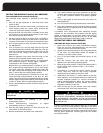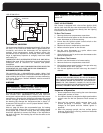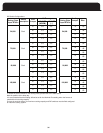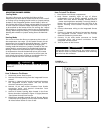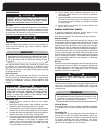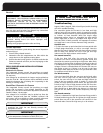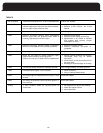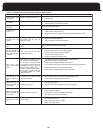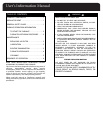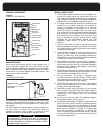
DO NOT OPERATE THE FURNACE WITHOUT AN AIR FILTER.
HOLES IN THE EXHAUST PIPING OR FURNACE HEAT
EXCHANGER CAN ALLOW TOXIC FUMES TO ENTER THE
HOME AND CIRCULATE THROUGH THE DUCT SYSTEM
RESULTING IN CARBON MONOXIDE POISONING OR
DEATH. IF LEAKS ARE FOUND IN THE FURNACE HEAT
EXCHANGER, IT MUST BE REPLACED.
A
ir Filter
The filter should be inspected frequently and cleaned as
necessary. We recommend a monthly inspection at first,
p
erhaps coinciding with the arrival of the monthly fuel bill
as a reminder. The frequency may be increased or decreased
depending on experience and conditions.
Lubrication
Both the induced draft blower motor and circulating fan
motor are ball bearing type motors. Neither requires
routine lubrication.
Operating Tips
1. Clean air filters maximize efficiency and reduce
heating costs.
2.
During the heating season, keep windows and doors
closed to reduce the heating load on the system.
3.
A
void excessive use of kitchen exhaust hoods and other
exhaust fans to reduce the heating load on the system.
4. Arrange the furniture and drapes so that the supply air
registers and return air grilles are unobstructed.
5. If you have a perimeter duct system, ideally, the warm
air should bathe the cold exterior walls. Avoid the use
of plastic deflectors on the supply air registers that
tend to short circuit the warm air straight into the
return air grilles. These deflectors are often the cause
of cool draughts across the floor
.
TABLE 8
M
B
C
D
5
On
6
On
5
On
T
30
30
Off
0
On
C
B
D
6
On
S
180
30
Off
On
The motor bearings were prelubricated by the motor
manufacturer. Do not attempt to lubricate them. Excess
lubrication will void the warranty, shorten the service
life of the motors, and will attract the buildup of dust
and dirt.
The induced blower motor and circulating fan motor must
be cleaned on a periodic basis by a qualified service
technician. Dust buildup in the ventilation ports of the motor
will cause the motor to not dissipate heat properly resulting
in reduced service life.
Vent Connector
The exhaust venting between the furnace vent box and
chimney should be inspected periodically for sags, pitting,
evidence of leakage etc. If any of these conditions exist,
contact your installation contractor, service agency or fuel
supplier.
DISCONNECT THE ELECTRICAL POWER SUPPLY TO THE
FURNACE BEFORE ATTEMPTING ANY MAINTENANCE.
FAILURE TO DO SO CAN CAUSE ELECTRICAL SHOCK
RESULTING IN PERSONAL INJURY OR LOSS OF LIFE.
MAINTENANCE
This is a critical connection. Small amounts of corrosion
can significantly increase the internal resistance of the
connection. A relatively small increase in resistance can
result in a large decrease in flame signal.
Induced Blower
The induced blower motor should be inspected and cleaned
if necessary. Clear any dust buildup from the ventilation
ports.
Circulating Fan
The condition of the circulating fan should be checked to
ensure that it is free of excessive dust buildup, debris, etc.
The mechanical fasteners should be inspected and checked
for proper tightness and parts alignment. The motor
ventilation ports should be cleaned if necessary to prevent
restriction to cooling by air over the motor.
BE CAREFUL WHEN WORKING ON THE BURNER
ASSEMBLY. THE HOT SURFACE IGNITER IS FRAGILE AND
CAN BREAK EASILY.
The flame sensor should be inspected and cleaned with fine
steel wool or Scotch-Brite™ scrubbing pad. The wiring
connection should be checked to ensure that it is tight and
corrosion free.
6. Avoid placing heat producing appliances such as
televisions, radios, lamps, etc. in a location to influence
the thermostat.
7. Keep combustible articles at least 3 feet away from the
furnace. Do not block access for servicing the furnace.
Do not use the vent connector as a hanger for clothes
or anything else.
8. Never attempt to operate the furnace without the
blower door in place.
ANNUAL INSPECTION / SERVICE
A qualified installation contractor, service agency or fuel
supplier must inspect the furnace annually.
Your annual inspection will normally cover the following:
Heat Exchanger
The heat exchanger should be inspected for corrosion. The
flue passages (heat exchanger tubes) should be free of scale
or excessive corrosion. Observe the burner flames. If there
appears to be flame distortion, check venting for blockage.
Also check for signs of inadequate combustion air supply. If
flame distortion continues after eliminating the blockage in
the venting as the cause, it may be necessary to replace the
tubular heat exchanger. The tubular heat exchanger cannot
be field cleaned. If the tubular heat exchanger is blocked by
soot or excess scale, replace it. Check NOX baffles (installed
in heat exchanger tubes) for any distortion. If distorted,
replace NOX baffles.
Burners
The burners should be inspected to ensure that they are free
of deterioration, dust and debris, and properly aligned with
the heat exchanger. In most cases, a simple vacuuming with
a brush attachment will adequately clean the burner
assembly and burner compartment.
WARNING
CAUTION
WARNING
CAUTION
IMPORTANT
IMPORTANT
38




